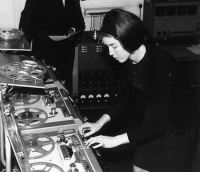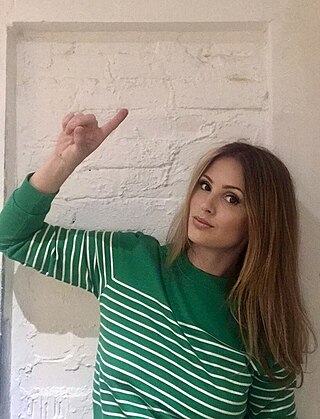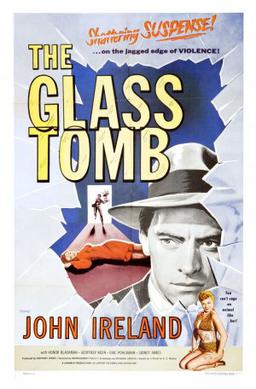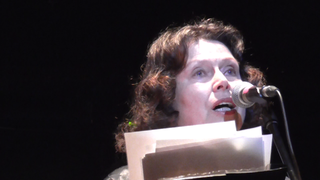Video art is an art form which relies on using video technology as a visual and audio medium. Video art emerged during the late 1960s as new consumer video technology such as video tape recorders became available outside corporate broadcasting. Video art can take many forms: recordings that are broadcast; installations viewed in galleries or museums; works either streamed online, or distributed as video tapes, or on DVDs; and performances which may incorporate one or more television sets, video monitors, and projections, displaying live or recorded images and sounds.

Laura Phillips "Laurie" Anderson is an American avant-garde artist, musician and filmmaker whose work spans performance art, pop music, and multimedia projects. Initially trained in violin and sculpting, Anderson pursued a variety of performance art projects in New York during the 1970s, focusing particularly on language, technology, and visual imagery. She achieved unexpected commercial success when her song "O Superman" reached number two on the UK singles chart in 1981.

Delia Ann Derbyshire was an English musician and composer of electronic music. She carried out notable work with the BBC Radiophonic Workshop during the 1960s, including her electronic arrangement of the theme music to the British science-fiction television series Doctor Who. She has been referred to as "the unsung heroine of British electronic music", having influenced musicians including Aphex Twin, the Chemical Brothers and Paul Hartnoll of Orbital.

Anne Waldman is an American poet. Since the 1960s, Waldman has been an active member of the Outriders Poetry Project experimental poetry community as a writer, performer, collaborator, professor, editor, scholar, and cultural/political activist. She has also been connected to the Beat Generation poets.
Sound poetry is an artistic form bridging literary and musical composition, in which the phonetic aspects of human speech are foregrounded instead of more conventional semantic and syntactic values; "verse without words". By definition, sound poetry is intended primarily for performance.

Elfriede Jelinek is an Austrian playwright and novelist. She is one of the most decorated authors to write in German and was awarded the 2004 Nobel Prize in Literature for her "musical flow of voices and counter-voices in novels and plays that, with extraordinary linguistic zeal, reveal the absurdity of society's clichés and their subjugating power". She is considered to be among the most important living playwrights of the German language.

Olga Neuwirth is an Austrian contemporary classical composer, visual artist and author. She gained fame mainly through her operas and music theater works, which often deal with topical and decidedly political themes of identity, violence and intolerance.
Günter Brus was an Austrian painter, performance artist, graphic artist, experimental filmmaker, and writer.

Michael Mantler is an Austrian avant-garde jazz trumpeter and composer of contemporary music.
Peter Joseph Moore was a Canadian music producer who was first recognized for his innovative recordings of the Cowboy Junkies, produced on a shoestring budget.
Lily Goddard was an Austrian textile designer. She attended the Vienna School of Art where she was taught by, among others, Professor Ernst Gombrich, Professor Joseph Hoffmann and Professor Czisek.

Grete Wiesenthal was an Austrian dancer, actor, choreographer, and dance teacher. She transformed the Viennese Waltz from a staple of the ballroom into a wildly ecstatic dance. She was trained at the Vienna Court Opera, but left to develop her own more expressive approach, creating ballets to music by Franz Schreker, Clemens von Franckenstein, and Franz Salmhofer, as well as dancing in her own style to the waltzes of Johann Strauss II. She is considered a leading figure in modern dance in Austria.

Jens Haaning is a Danish conceptual, contemporary artist living and working in Copenhagen. His subject matter includes changing society in the West, power and communication in the global society, migration, displacement, nationalism, and human coexistence.

Friederike Mayröcker was an Austrian writer of poetry and prose, radio plays, children's books and dramatic texts. She experimented with language, and was regarded as an avantgarde poet, and as one of the leading authors in German. Her work, inspired by art, music, literature and everyday life, appeared as "novel and also dense text formations, often described as 'magical'." According to The New York Times, her work was "formally inventive, much of it exploiting the imaginative potential of language to capture the minutiae of daily life, the natural world, love and grief".

Georgina Richards-Pringle is an artist, music producer, Radio DJ, performer, writer and curator from London, UK. She is best known for her stream-of-consciousness style poetry and prose delivered over backing tracks which she creates on GarageBand music software.

The Glass Cage is a 1955 British second feature mystery film, directed by Montgomery Tully and starring John Ireland, Honor Blackman and Sid James. It was made by Hammer Film Productions. The film is based on the novel The Outsiders by A.E. Martin.

Katalin Ladik is a Hungarian poet, performance artist and actress. She was born in Újvidék, Kingdom of Hungary, and in the last 20 years she has lived and worked alternately in Novi Sad, in Budapest, Hungary and on the island of Hvar, Croatia. Parallel to her written poems she also creates sound poems and visual poems, performance art, writes and performs experimental music and audio plays. She is also a performer and an experimental artist. She explores language through visual and vocal expressions, as well as movement and gestures. Her work includes collages, photography, records, performances and happenings in both urban and natural environments.
Christine Kozlov was an American conceptual artist.

Rena Rosenthal (1880–1966) was a trend-setting American retailer and businesswoman. Known principally for her exclusive Madison Avenue retail shop in New York City, she was an influential arbiter of taste and fashion in the interior decorating world, particularly during the introduction of modernism to North America.

Rena Pfiffer-Lax-Madsen, usually seen as Rena Pfiffer-Lax, was a Polish soprano opera singer based in Austria and Denmark, and associated with Viennese opera houses in the 1920s.














